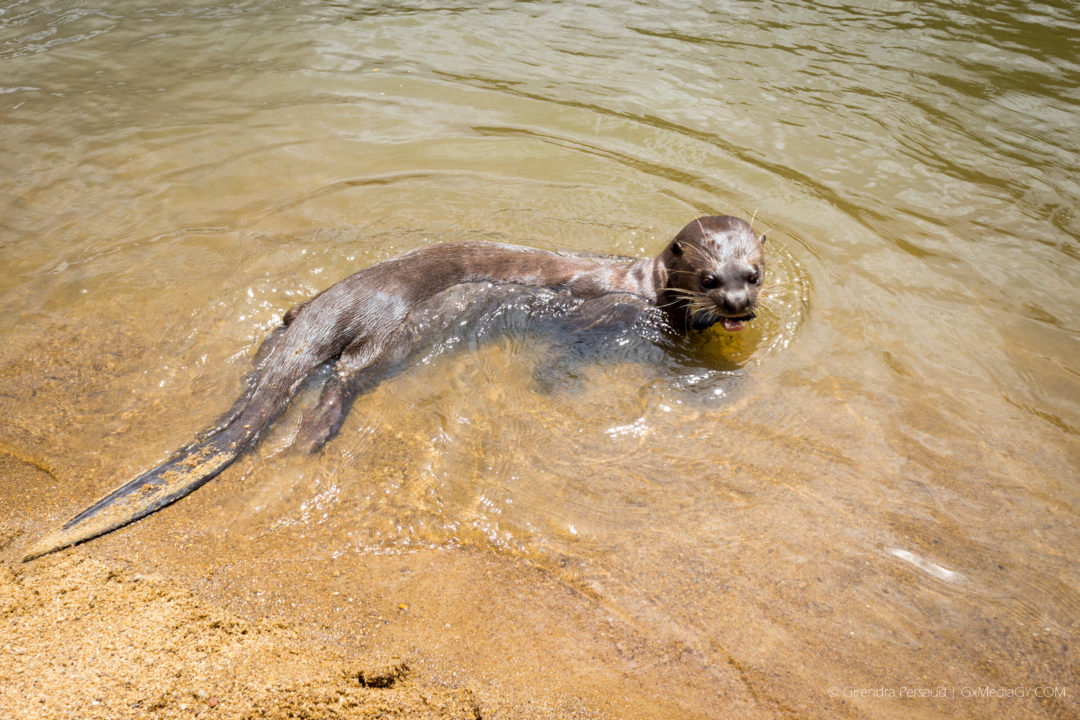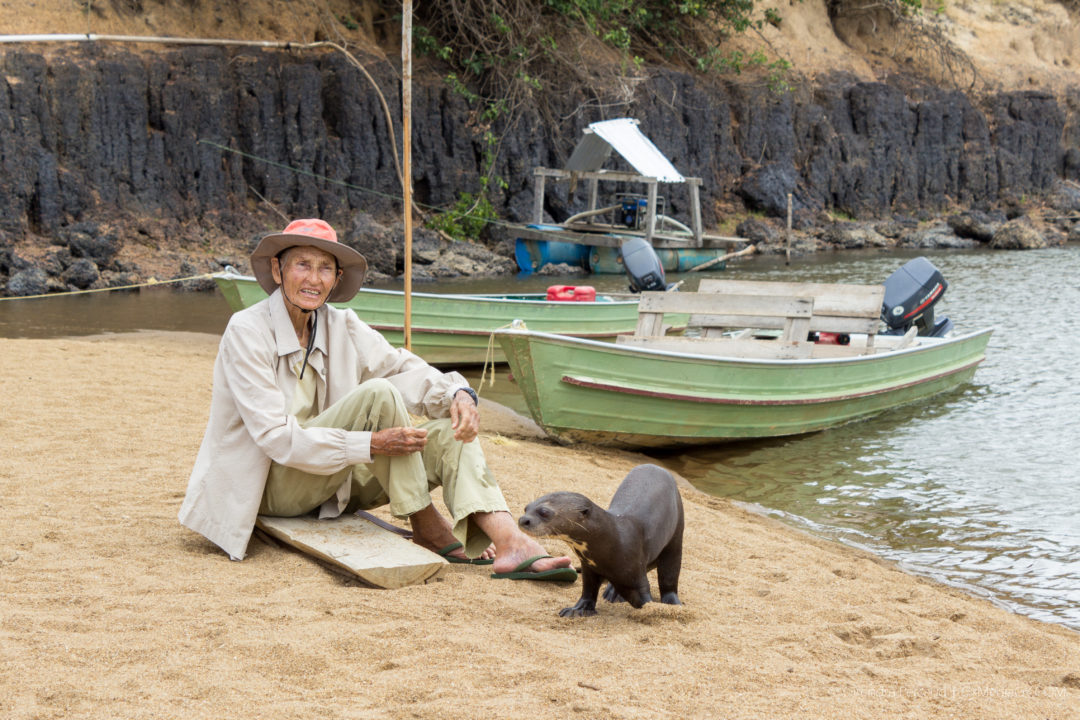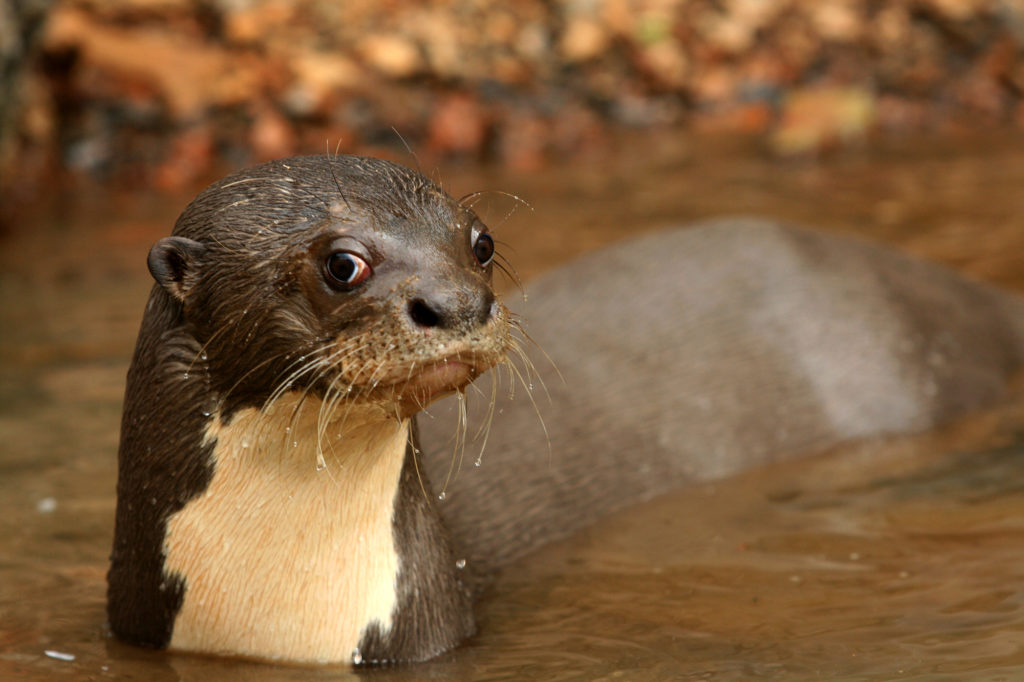The giant river otter is the longest member of the Mustelidae or weasel family. They are often referred to as the river wolf and are the largest otters in the world. Giant river otters are very sociable and live in families of between 3 – 10 individuals that hunt together. They are semi-aquatic mammals, which means that they need both land and water habitat to survive. Also, they can have up to nine different type of vocalizations and they don’t have any natural predators, but they can compete for food with other species such as the black caiman, the neotropical river otter and, of course, the human.
Species of Otters
There are thirteen extant species of otter around the world.
- Eurasian otter
- Hairy-nosed otter
- Spotted-necked otter
- Smooth-coated otter
- North American river otter
- South American river otter
- Neotropical river otter
- Marine otter
- Giant otter
- Asian small-clawed otter
- African clawless otter
- Congo clawless otter
- Sea otter
The Giant River Otter
The giant river otter is a South American Carnivorous mammal. They are a globally successful group of predators and they can reach up to 6 feet in length. They are generally peaceful but it has been observed that they are territorial and aggressive towards others; the groups mark their ranges with latrines, gland secretions, and vocalizations. The giant river otter is diurnal, being active exclusively during daylight hours. It is also noted that they are the noisiest otter species and their distinct vocalizations indicate alarm, aggression and reassurance.
 Male otters are between 4.9 and 5.6 feet in length from head to tail and females between 3.3 and 4.9 feet. The otter’s well-muscled tail can add a further 70 cm (28 inch) to the total body length. The males weigh between 57 and 71 pounds and the females between 49 and 57 pounds. They have the shortest fur of all otter species; they are typically chocolate brown, but may be reddish or fawn, and appears nearly black when wet. As for the fur, it is extremely dense, so dense that water cannot penetrate to the skin.
Male otters are between 4.9 and 5.6 feet in length from head to tail and females between 3.3 and 4.9 feet. The otter’s well-muscled tail can add a further 70 cm (28 inch) to the total body length. The males weigh between 57 and 71 pounds and the females between 49 and 57 pounds. They have the shortest fur of all otter species; they are typically chocolate brown, but may be reddish or fawn, and appears nearly black when wet. As for the fur, it is extremely dense, so dense that water cannot penetrate to the skin.
The giant river otter muzzles are short and sloping which gives the head a ball-shaped appearance. The ears are small and rounded; the nose (or rhinarium) is completely covered in fur, with only the two slit-like nostrils visible. Their highly sensitive whiskers (vibrissae) allow them to track changes in water pressure and currents, which aids in detecting prey. Their legs are short and stubby and end in large webbed feet tipped with sharp claws. It can close its ears and nose while underwater which makes it well suited for an aquatic life.
Tip: How does the giant river otters socialize?
They hunt cooperatively and share babysitting duties. The groups do not fight with each other. Each group’s stable social structure is centered on the life-bonded dominant pair, which is the only pair that reproduces. The groups are strongly cohesive – they sleep, play, travel, and feed together; their social calendars include grooming, hunting, resting, and communicating.
Scientific Classification of the Giant River Otter
Giant River Otter – Pteronura brasiliensis (Scientific Name)
Kingdom: Animalia
Phylum: Chordata
Class: Mammalia
Order: Carnivora
Family: Mustelidae
Genus: Pteronura
Species: P. brasiliensis
Diet of the Giant River Otter
Fish make up most of the giant river otter’s diet; including cichlids, characins (such as piranha), and catfish. They hunt alone or in groups; sometimes they use coordinated efforts. Each animal may eat six to nine pounds of food per day. They also eat crustaceans and sometimes catch small caimans and small anacondas.
Habitat of the Giant River Otter
They live along reaches of slow-moving rivers or creeks, especially in areas adjacent to wetlands like marshes and swamps. Other water habitats include freshwater springs and permanent freshwater lakes. Preferred habitat features include high banks for denning, thick vegetation and high fish densities. They choose clear, black waters with rocky or sandy bottoms over silty, saline, and white waters.
Reproduction of the Giant River Otter
The animal reaches sexual maturity at about two years of age. Females give birth between August and September and the young pups emerge for the first time in October and November. Births may peak during the dry season. The entire group, including nonreproductive adults, which are usually older siblings to the pups, collaborates to catch enough fish for the young. Females have a gestation period of 65 to 70 days and the group raises one to five cubs annually.
Pups open their eyes in their fourth week, begin walking in their fifth, and are able to swim confidently between 12 and 14 weeks old. They are weaned by nine months and begin hunting successfully soon after. Both male and female pups leave the group permanently after two to three years.
Did You Know?
They can live up to 10 years in their natural habitat.
The Giant River Otters
They love socializing as a group and their nine different types of vocalizations makes them unique. A giant river otter can be found in the Guyana’s Zoo; he loves to swim and entertain those who come to visit him. He is one of the major attraction in the Zoo where he has a huge pool to swim. The river otters can also be found in the rivers and lakes in Iwokrama and the North Rupununi.
Diane McTurk – The Otter Lady In The Rupununi

By necessity, Diane became a world expert on the care and rehabilitation of the Giant Otters. She has raised over 40 orphaned otter cubs, returning most of them to the wild for a chance at freedom. In 1997, Diane, with the support of the McTurk family, established the Karanambu Trust as a private charity. See more: https://www.thingsguyana.com/meet-diane-mcturk/
Article References:
- https://en.wikipedia.org/wiki/Giant_otter
- https://news.nationalgeographic.com/news/2013/10/131023-giant-river-otter-animals-science-reddit/
- https://www.nationalgeographic.com/animals/mammals/g/giant-otter/
- https://amazonaid. https://peru.wcs.org/en-us/Wildlife/Giant-River-Otter.aspxorg/species/giant-river-otter/







